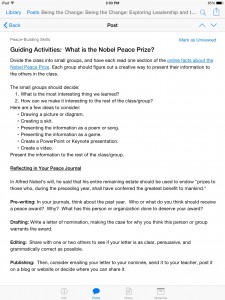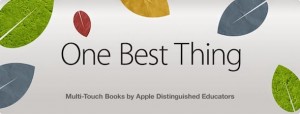Celebrate Kansas Voices was probably one of my favorite projects in class. As much pride as I have for the community, and this high school, I knew that it had a rich history that our new generation doesn’t fully know about. This project allowed me to dig deeper than my knowledge, and go beyond the history of our school, that was lost and recovered, using old books, photos, and background information. Junction City High School was a school that was considered “The finest in the state,” by the territorial governor, and the new superintended. I chose this school not only because of the history, but because I figured out that there’s many stories that are shared throughout the community. The more years we move forward, the more we lose people, stories, and little by little, traditions. It’s the new generation’s opportunity to add, and I would hope that this will be the start of something that can be left behind. Since video production is my specialty, I also loved this project for that reason. I have never done a documentary type video, but even though you don’t have to show yourself, you still have to rehearse what you’re speaking, and know when are the right times to say things. There were a few times I had to stop after I had messed up, but it’s always best to know that nothing is ever perfect the first time. By clicking here, this will explain all about ‘Celebrate Kansas Voices’, and will give you details on what a student, or teacher can do, to showcase historical stories from different parts of Kansas. This is great to learn about History within our state.
Month: July 2015
Apps in the Classroom: Art Authority
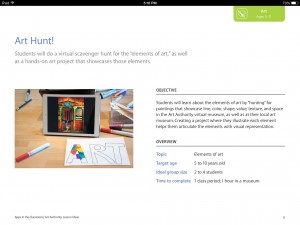 Apps in the Classroom offers 18 different apps that are recommended for teachers. They are all grouped in subjects, but they’re all great for fun uses for the students. It’s a way for teachers to integrate the apps and activities that is modified. Art Authority is an App that I am exploring, and it allows a student to travel beyond the realm of visualizing art at a museum, Students have the opportunity to compare art based on location, subject, and explore through different time periods. There’s activities that range based on the age level; 5-11, 12-14, and 14-18, so in other words, it is great for both middle school students, and high school students. In each category of the ages, they all provide an objective. This app that is design for ages 5-11, talks about how to color, and what is necessary in need for coloring a visual representation. There are many different activities that come with this and allows it to be considered a favorite.
Apps in the Classroom offers 18 different apps that are recommended for teachers. They are all grouped in subjects, but they’re all great for fun uses for the students. It’s a way for teachers to integrate the apps and activities that is modified. Art Authority is an App that I am exploring, and it allows a student to travel beyond the realm of visualizing art at a museum, Students have the opportunity to compare art based on location, subject, and explore through different time periods. There’s activities that range based on the age level; 5-11, 12-14, and 14-18, so in other words, it is great for both middle school students, and high school students. In each category of the ages, they all provide an objective. This app that is design for ages 5-11, talks about how to color, and what is necessary in need for coloring a visual representation. There are many different activities that come with this and allows it to be considered a favorite.
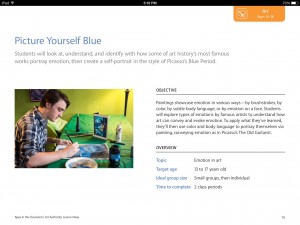 This App isn’t just about Art, but you can also incorporate literacy, for example, you can allow poetry to be mixed in with the art, as well as reading different styles. Below are different photos. As the grade level progresses, the activities get more mature, and once it gets to the middle and high school level, you actually do some hands on art. This would be a great activity to use in the classroom for historical purposes, but great to learn about things that are visual. It will be great to use this instead of going to the museum. This App may require an in App purchase.
This App isn’t just about Art, but you can also incorporate literacy, for example, you can allow poetry to be mixed in with the art, as well as reading different styles. Below are different photos. As the grade level progresses, the activities get more mature, and once it gets to the middle and high school level, you actually do some hands on art. This would be a great activity to use in the classroom for historical purposes, but great to learn about things that are visual. It will be great to use this instead of going to the museum. This App may require an in App purchase.
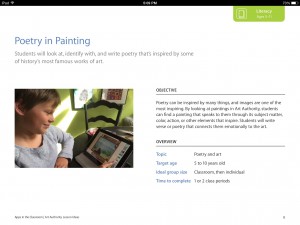
Inspiring Lessons For The Classroom: Exploring Leadership
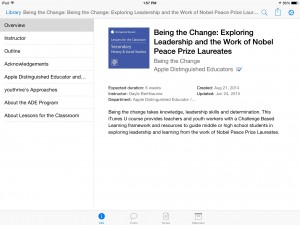 Inspiring Lessons for the classroom offers unit resources that is great for educators to teach their students with. In this app, there are thirty different subjects and lessons to choose from. Here’s a great one that I have explored, and that is, Being the Change: Exploring Leadership and the work of Nobel Peace Prize Laureates. This course is expected to last throughout a period of six weeks, and the instructor who is in charge is, Gayle Bethiaume. She is an educator with over 35 years of experience, and teaches across the United States, and even where she resides.
Inspiring Lessons for the classroom offers unit resources that is great for educators to teach their students with. In this app, there are thirty different subjects and lessons to choose from. Here’s a great one that I have explored, and that is, Being the Change: Exploring Leadership and the work of Nobel Peace Prize Laureates. This course is expected to last throughout a period of six weeks, and the instructor who is in charge is, Gayle Bethiaume. She is an educator with over 35 years of experience, and teaches across the United States, and even where she resides.
We begin with knowing who Alfred Nobel is, and how students can get a sense of what is the Nobel Peace Prize. It allows students to keep track of a journal with their work, which in this case, is called Peace Journals.
Leadership development is a key to gain knowledge about the Nobel Peace Prize, and recipients of the Nobel Peace Prize. There is a post that lists the four rules for engaged leadership. Things like these, and other items presented in this course, will show itself as a team building activity.
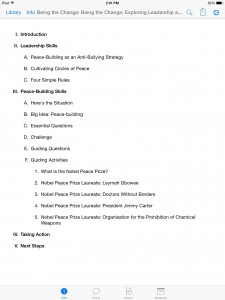
Throughout this course, there is also selection located at the bottom called “Materials” that has more books, handouts, and other information regarding the subject. All that is required is downloading them, and you’ll able to receive. If you go to the App store, you will need to download the U App, and click on For Educators, and you will see the thirty lessons that is created. The App may look very complex, but once you fool around with it, it will become very easy to follow through. It’s a lot of material to cover, but it’s great material used for a middle school and high school student. I would hope that this course will be great to learn about being a leader, versus trying to win a prize.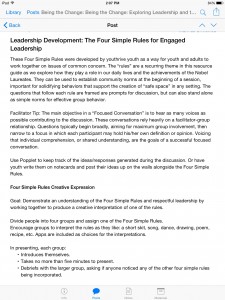
One Best Thing: Self-Publishing
One Best Thing, are free iBooks that is available for students, teachers, and future educators. It offers different advice on how to incorporate different strategies and technological resources in the classroom. The one that I was reading, offered tips on how to publish student books through the iPad. Jane Amanda Ross offers different examples of students learning something about their personal life, and their culture. I find that this is very useful to students in Elementary school because, students will always have an opportunity to showcase their works of writing. Rather than have stories shown at a school function, or for their resourceful benefits, publishing students work is an opportunity to showcase the world, and other educators what they do. 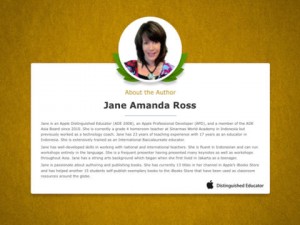
This is a great way to educate students on a lesson of what publishing is all about. We are in the digital age in which authors are self-publishing stories through online sources such as, Amazon, Kindle, and eBook. It’s a great way of teaching students on what it takes to become an Author, publisher, and an illustrator. This iBook, along with other iBooks, contain so much great material that can always be incorporated into the classroom. I love the fact that Apple is making things for teaching resources, available for many educators.
Digital Story Telling
Adobe Slate is a unique App that offers students and educators, create stories that our easy to read, and great to share to with other people. In this App, I used Adobe Slate, and created a story about how musicals are put together. Though I didn’t get truly specific, I made sure to point out the specific factors and how it’s formed. Instead of telling a story, you can also inform people about some facts, or even show historical pictures along with information or a question. Compared to the other App, Adobe Voice, you do not have to record your voice, but I do think that this is an easier product because it’s simple, it’s not hard to find things, and it’s very easy to navigate around the app. This is App is free, but it also may require some in-App purchases, which means that some components in the app may require a purchase.
Below is my video of How A Show is Formed.
Justin McLachlan: Writing Dialogue.
Justin McLachlan is from a small town south of Pittsburg, and spent his life in San Diego, Morgantown, West Virginia, and is currently in Washington D.C. where he also received his bachelor’s degree from Taylor University in mass communications. What makes Justin unique, is that he’s in fact a write, actor, and director. Justin is also the creator of EOS 10, a science fiction radio play and podcast series.
is from a small town south of Pittsburg, and spent his life in San Diego, Morgantown, West Virginia, and is currently in Washington D.C. where he also received his bachelor’s degree from Taylor University in mass communications. What makes Justin unique, is that he’s in fact a write, actor, and director. Justin is also the creator of EOS 10, a science fiction radio play and podcast series.
I came upon his blog when I was searching on Pinterest for great creative writing ideas to use in my classroom. I noticed that there was a great written post called, 5 Reasons Your Dialogue Isn’t Authentic. It wasn’t too long, but it was short, sweet, and to the point. So is it hard to write authentic dialogue? Absolutely. When writing a story, it’s almost like writing an essay, and at times, we want to sound formal, but what Justin points out for those who are writing scripts and stories, is that you have to write how you would say it in person. A tip that he suggested, is to say it out loud, rephrase, and rewrite it.
This is one of many blogs that is found on Justin’s website. It’s great to use it for English students, drama students, and film students. These posts are something that I would recommend to my students, and have them learn from what he says.
